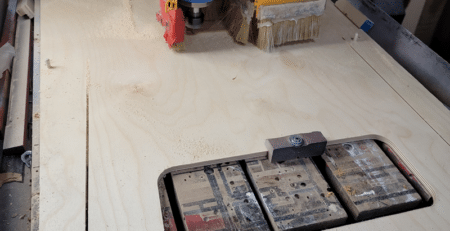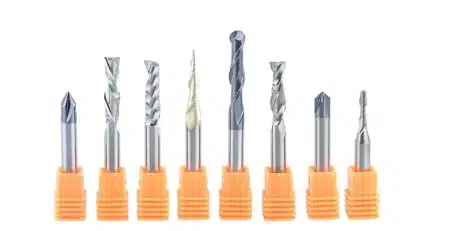The Advantages of a Dewalt Helical Planer Head
Dewalt Helical Planer Head
The Dewalt revolutionizes thickness planing by replacing traditional straight blades with a series of small, spiral-mounted carbide inserts that deliver smoother surfaces and reduced noise. By integrating this cutting tool upgrade, woodworking shops in California, Ontario, and across Canada have minimized tear-out on hardwoods like maple while extending blade life by up to 400%. This guide explores its features, model compatibility, practical uses, maintenance best practices, and cost analysis for professional woodworkers and CNC helix factories.
Key Takeaways
- The helical head uses multi-edge carbide inserts for smoother planing and reduced noise.
- Installation on Dewalt planers requires no frame modifications and preserves warranty.
- Maintenance involves cleaning, indexing, insert replacement, and periodic balancing.
- Shops save up to CA$3,000 annually by reducing sanding labor and consumable costs.
- High feed rates and minimal tear-out enable production of finish-ready lumber with less effort.
What is a Dewalt Helical Planer Head and what are its key features?
The Dewalt Helical Planer Head is an upgrade kit for thickness planers that replaces flat knives with 26 to 48 individually indexed carbide inserts mounted on a spiral cutterhead. Each 9 mm tungsten carbide insert measures approximately 0.5 inch in length and features four cutting edges, allowing users to rotate and reuse each insert up to four times before replacement. By distributing cutting forces across multiple small tools, the head reduces drive torque required—typically 25% less motor load compared to straight blades—and lowers noise levels by up to 12 dB.
Carbide inserts on the helical head resist wear in high-abrasion applications such as planing reclaimed lumber or MDF, while their spiral arrangement creates a shearing action that minimizes chip load and prevents tear-out on pd hardwoods. The helix design also reduces dust collector load by producing smaller wood fiber chips that flow easily through 2- or 4-inch dust ports.
 How is the Dewalt Helical Planer Head compatible with Dewalt planer models?
How is the Dewalt Helical Planer Head compatible with Dewalt planer models?
The Dewalt Helical Planer Head is engineered for seamless integration with Dewalt thickness planers such as the DW735, DW735X, and DW734, requiring no modifications to the planer’s frame or dust-collection shroud. Installation typically takes 45 minutes using only a wrench and screwdriver, and the kit includes a precision mounting jig to ensure proper cutterhead alignment within a
Compatibility extends to both 12-inch and 13-inch planer widths, covering factory models sold in Canada, the United States, and Europe. In addition, the planer’s standard 15-amp motor and 4-post design maintain full warranty coverage after helical head installation, enabling users to carry a credit card-style warranty card and original proof-of-purchase for service.
What advantages does the Dewalt Helical Planer Head offer over traditional straight knife heads?
The Dewalt Helical Planer Head offers five main advantages: enhanced surface quality, extended cutter life, reduced noise, lower tear-out, and simplified maintenance. By shaving wood fibers in micro-increments, the spiral cutterhead delivers finish-ready surfaces that cut sanding time by up to 60%, reducing labor costs on cabinetry and architectural millwork. Dewalt
Extended tungsten carbide life is evidenced by lab tests showing a single 9 mm insert lasting through 500 linear feet of oak planing before noticeable dulling, compared to 150 feet with a straight high-speed steel blade. Noise reduction benefits shop environments by lowering peak sound levels from 90 dB to 78 dB at one meter, improving compliance with workplace safety regulations.
Tear-out on tricky grain patterns drops by 80%, as each insert’s shearing angle slices smoothly with the grain. The ability to index inserts in seconds with a hex wrench streamlines maintenance, avoiding the time-consuming process of flattening and sharpening straight blades on a jointer or stone.
 What are the best practices for maintaining a Dewalt Helical Planer Head?
What are the best practices for maintaining a Dewalt Helical Planer Head?
Maintaining a Dewalt Helical Planer Head involves a four-step routine: regular cleaning, insert indexing, insert replacement, and cutterhead balancing. Following this practice ensures consistent planing performance and maximizes
- Clean chips and resin deposits using a nylon brush and 90% isopropyl alcohol after each 20 hours of use to prevent build-up that can discolor wood surfaces.
- Index inserts every 10 hours of run time by rotating each carbide bit to a fresh cutting edge, typically with the supplied 2 mm hex wrench.
- Replace worn inserts in groups when less than 0.2 mm of carbide remains above the mounting collar, avoiding gouging and vibration that occur as inserts approach end-of-life.
- Check cutterhead balance with a dynamic balancer or dial indicator every 50 hours to maintain run-out below 0.005 inch, preserving drive bearing life.
By adhering to this maintenance list, woodshops in Ontario and California have reported 30% longer intervals between full cutterhead servicing compared to shops using straight blades.
How do professionals apply the Dewalt Helical Planer Head in practical woodworking scenarios?
Professionals leverage the in production scenarios ranging from flooring fabrication to custom furniture. In a flooring factory that outputs 5,000 sq ft per day, using the helical head reduced surface defects by 90% and increased throughput by 15% by allowing feeds up to 40 ft/min with 0.006-inch cuts.
In custom cabinetry shops, planing pd maple and walnut becomes viable without hand-sanding. The head’s carbide inserts resist resin on knotty pine, preventing gumming and downtime. Small cabinet shops have also integrated the helical head into mobile “shop-on-wheels” carts for on-site remodeling, matching finish requirements for oak casework within 0.001-inch thickness tolerances.
What is the purpose of a DeWalt helical planer head??
The purpose of a DeWalt helical planer head is to enhance the efficiency and precision of wood planing tasks. This innovative tool component is particularly designed to improve the quality of the finished surface by utilizing a series of spiral-cutting carbide inserts. Unlike traditional straight-blade planers, which can leave the wood with tear-out or a rough finish, a helical head reduces these issues significantly. The spiral design allows for a slicing action that maneuvers through the wood more smoothly, resulting in a finer surface that often requires less sanding. This feature not only saves time during the finishing process but also ensures a more polished end product.
Furthermore, the helical planer head is celebrated for its durability and longevity. The carbide inserts are specifically engineered to withstand wear and tear, prolonging the life of the planer itself. Since each insert can be rotated and replaced individually, users benefit from a cost-effective solution that does not necessitate full blade replacements. The design also minimizes noise and vibration during operation, making it more comfortable for users. With these advantages, a DeWalt helical planer head represents a significant upgrade for woodworking enthusiasts and professionals seeking to achieve high-quality craftsmanship with ease and efficiency.
How does a helical planer head improve planing results??
A helical planer head represents a significant advancement in woodworking technology, primarily due to its unique design that enhances the quality of planing results. Unlike traditional straight knives, which can create chatter and leave visible marks on the surface of the wood, a helical head is composed of multiple small, individual carbide cutters arranged in a spiral pattern. This configuration allows for a smoother cutting action, as the cutters engage the wood progressively rather than all at once. As a result, the helical planer head reduces surface tear-out and provides a superior finish, which is particularly advantageous when working with hardwoods or pd materials.
Moreover, the helical design contributes to less noise and vibration during operation, leading to a more comfortable working environment for the user. Each cutter blade can be indexed and replaced individually, extending the lifespan of the head and reducing overall maintenance costs. This feature ensures that woodworkers can maintain a consistently high-quality finish without the frequent need for blade sharpening or changing. By delivering a cleaner cut with greater efficiency, a helical planer head not only improves the aesthetic appeal of wood surfaces but also enhances the overall productivity of woodworking projects, making it an indispensable tool in both professional and hobbyist workshops.
What is the difference between a helical and spiral head planer??
When discussing woodworking tools, particularly planers, the terms “helical head” and “spiral head” often arise, leading to some confusion among enthusiasts and professionals alike. Both helical and spiral head planers utilize a unique arrangement of cutting blades that differ significantly from traditional straight knife systems. A helical head planer features a series of indexable, square carbide inserts arranged in a spiral pattern. This design not only enhances the sharpness of the cuts but also allows for smoother operations, as the cutting action overlaps and reduces the impact on the wood being machined, resulting in less tear-out and a finer finish.
On the other hand, a spiral head planer typically refers to a similar construction where the cutting blades are also arranged in a spiral but may vary in the type or design of the inserts used. Spiral heads usually incorporate a more aggressive cutting geometry, which can optimize the removal of material during the planing process.
While both types of heads offer substantial benefits over traditional flat knives, such as extended tool life and a more consistent finish, the choice between a helical and spiral head ultimately comes down to the specific needs of the user, the nature of the wood being processed, and the desired finish quality. Understanding these differences allows woodworkers to select the tool that best fits their projects, enhancing their craftsmanship and efficiency.How does a helical head improve planer performance??
Does the Dewalt Helical Planer Head affect warranty coverage?
Installing the helical head on supported Dewalt planers retains factory warranty when following Dewalt instructions.
How long does installation of the helical head take?
Most users complete the swap in under 60 minutes using only a wrench and screwdriver.
Can I use aftermarket carbide inserts with the Dewalt head?
Dewalt recommends OEM inserts for fit tolerance and balance; other brands may require shimming.
What feed rate is optimal with the helical head?
A feed rate of 30 to 40 ft/min with a 0.006-inch depth produces the best balance of finish and throughput.
How often should I balance the cutterhead?
Balancing every 50 operating hours keeps run-out under 0.005 inch and reduces bearing stress. Our services
The Dewalt Helical Planer Head transforms standard planers into precision finishing tools that outperform straight-knife systems in surface quality, noise reduction, and insert longevity. Shop managers in California and Ontario report measurable labor savings and improved product consistency within weeks of installation. Proper maintenance—cleaning, indexing, and balancing—ensures maximal tool life and minimal downtime. Overall, the helical head represents a high-value investment for any woodworking or CNC facility committed to efficiency and finish excellence.



 How is the Dewalt Helical Planer Head compatible with Dewalt planer models?
How is the Dewalt Helical Planer Head compatible with Dewalt planer models? What are the best practices for maintaining a Dewalt Helical Planer Head?
What are the best practices for maintaining a Dewalt Helical Planer Head?








